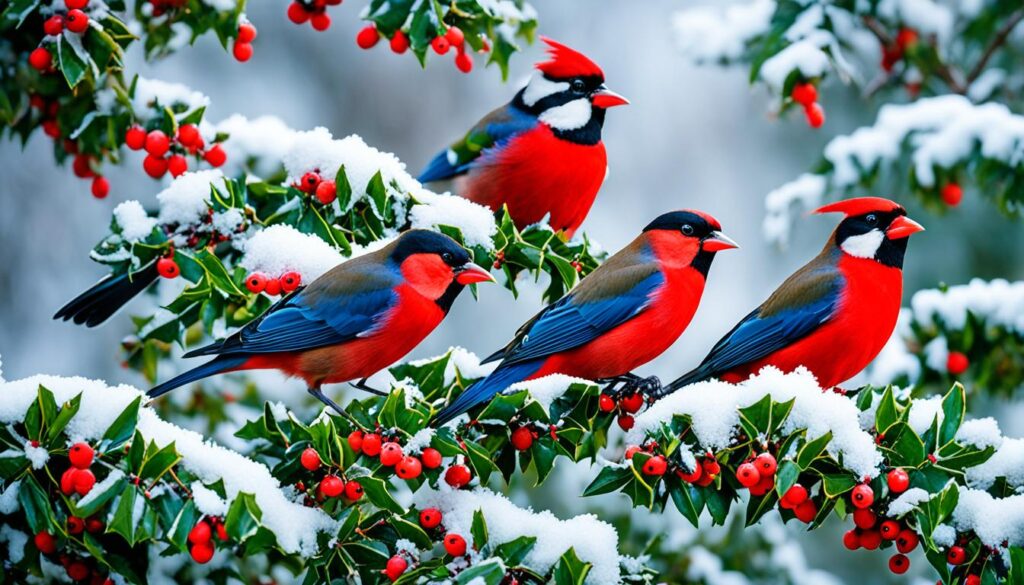Did you know that there are more than 400 species of holly trees worldwide, with these evergreen shrubs providing a vital food source for a diverse array of bird species during the winter months? From thrushes to warblers, woodpeckers to mockingbirds, these feathered friends flock to holly bushes to feast on the nutrient-rich berries, ensuring their survival through the coldest seasons. This article explores the remarkable world of birds that depend on holly berries, shedding light on their unique dietary habits and the importance of these ornamental plants in creating a thriving backyard wildlife habitat.
Key Takeaways
- More than 400 species of holly trees exist worldwide, providing a vital food source for birds in the winter.
- A diverse array of bird species, including thrushes, bluebirds, cedar waxwings, and warblers, rely on holly berries for survival during the colder months.
- Holly trees are drought-resistant, low-maintenance, and attractive to both pollinators and birds, making them an excellent choice for backyard wildlife habitats.
- Proper care and placement of holly bushes can help support local bird populations by offering a reliable source of winter sustenance.
- Understanding the importance of holly berries in a bird’s diet can inform effective strategies for protecting and promoting these ornamental shrubs.
A Feast for Feathered Friends
As winter approaches and insects disappear, trees and shrubs offer a vital food source for many bird species – their persistent, bite-sized fruits. Among these, holly berries stand out as a winter delight, captivating a variety of feathered friends with their bright red color and high nutrient content.
Holly Berries: A Winter Delight
Holly berries are not only visually striking but also highly nutritious. Bursting with natural sugars and healthy fats, they provide birds with a sustainable and efficient source of energy, helping them maintain their energy levels during the colder months when food sources become scarcer. The high water content of berries also offers a valuable source of hydration, especially important when traditional water sources may freeze over.
Attracting Birds with Berries
Planting holly bushes or trees can be an effective way to attract a diverse array of berry-eating birds to your backyard wildlife habitat. Birds can choose from a variety of berries, including elderberries, juniper berries, and crabapples, catering to different taste preferences and ensuring a balanced diet. By providing a winter bird feeding station filled with these nutritious treats, you can invite a delightful array of feathered friends to your backyard and witness their vibrant holly berry feast.
Feasting on berries not only nourishes birds but also helps them inadvertently contribute to the health of ecosystems by aiding in seed dispersal and the propagation of plant species. So, by welcoming these berry-loving birds, you can play a role in supporting a thriving backyard wildlife habitat.
“Berries are a vital food source for birds, especially during the harsh winter months when traditional sources become scarce. By planting berry-producing trees and shrubs, we can create a welcoming feast for our feathered friends.”
Thrushes and Their Berry-Filled Diet
Thrushes, a group of birds known for their melodious songs, play a vital role in the winter ecosystem as avid berry-eaters. These feathered foragers, including the widespread American robin, the striking Townsend’s solitaire, and the elusive hermit thrush, rely heavily on a diverse array of berries to sustain themselves during the colder months.
As the ground hardens and other food sources become scarce, these berry-eating birds turn to the abundant offerings of holly, juniper, and mistletoe to fuel their winter survival. Thrushes are often observed fiercely guarding their chosen berry trees, determined to secure a bountiful feast for themselves.
“In the winter months, birds rely significantly on berries as a food source when other food options are limited and the ground is hard to forage for insects.”
The varied thrush, a species found in the Pacific Northwest, is particularly adept at navigating the berry-filled landscape. Its striking plumage and distinctive call make it a sought-after sight for birdwatchers during the winter season.
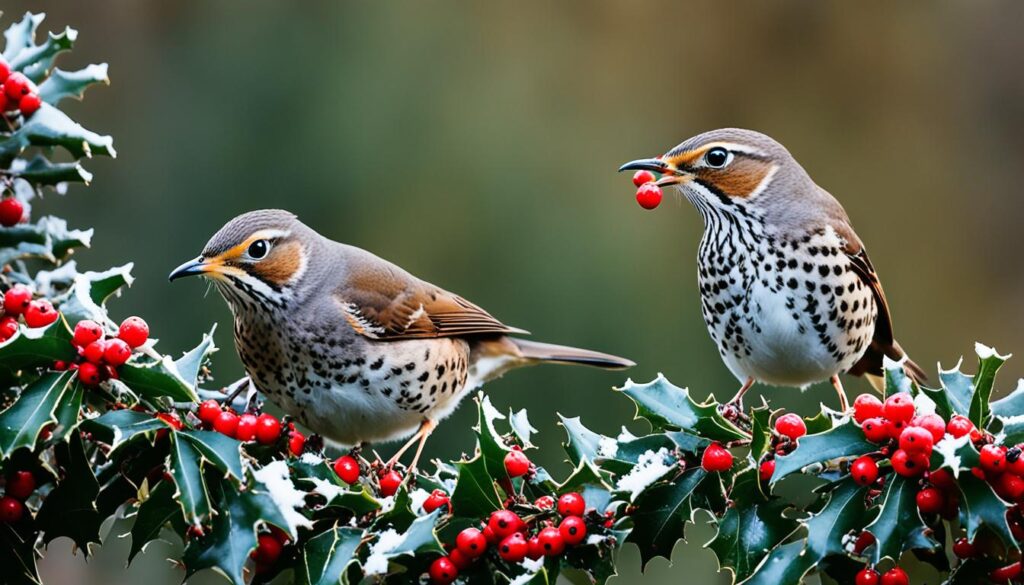
Thrushes’ ability to consume a wide variety of berries, including those that are toxic to other animals, sets them apart as versatile and adaptable foragers. This adaptability allows them to thrive in diverse habitats and ensures their survival even during the harshest winter conditions.
- Thrushes, such as the American robin, Townsend’s solitaire, and hermit thrush, are known to heavily rely on berries during the winter season.
- These birds forage on a variety of berries, including those from holly, juniper, and mistletoe, to sustain themselves when other food sources are scarce.
- Thrushes often fiercely guard their chosen berry-producing trees, ensuring a bountiful feast for themselves.
- The varied thrush, found in the Pacific Northwest, is a particularly notable berry-eating thrush species.
- Thrushes’ ability to consume a wide range of berries, including those toxic to other animals, makes them adaptable and versatile foragers.
Bluebirds: The Holly Berry Hunters
As insects become scarce in the winter months, bluebirds turn to berries as a vital food source. These vibrant blue birds are particularly drawn to the bright red fruits of the winterberry and the evergreen holly, finding a much-needed banquet that can keep them in an area for several weeks. Bluebirds aren’t picky eaters – they’ll gladly feast on almost any available berries, including those from the poisonous ivy plant.
In late winter, you can spot bluebirds foraging alongside other berry-loving birds like robins, northern flickers, and downy woodpeckers. They flock to the fuzzy spires of staghorn sumac, eagerly consuming the tart berries that provide critical sustenance during the leanest of seasons.
Providing a Banquet for Bluebirds
By planting native berry-producing shrubs and trees in your backyard, you can create a veritable feast for bluebirds and other berry-eating birds. The American holly, with its glossy green leaves and vibrant red berries, is a particularly attractive option. These trees can grow between 15 and 40 feet tall, and those grown in full sun are more likely to produce an abundant crop of fruit.
In contrast, the non-native Chinese holly does not offer the same habitat benefits for wildlife. Native plants like the American holly are better adapted to support local backyard wildlife habitat and provide a reliable food source for a diverse range of bird species.
“In a short 15 minutes, 13 species of birds were spotted in and around a single American holly tree.”
By inviting the bluebirds to your backyard with a bountiful berry buffet, you can enjoy the vibrant colors and lively presence of these delightful bluebirds throughout the winter months.
Cedar Waxwings: The Social Berry Connoisseurs
Among the avian fanatics eagerly awaiting the arrival of the winter berry feast are the captivating cedar waxwings. Known for their impeccable social skills and discerning taste, these berry-eating birds flock to junipers, hollies, and other fruit-bearing plants, feasting on the plentiful bounty.
Cedar waxwings are true connoisseurs of the berry world, with their diet consisting primarily of these bite-sized delights. From flowering crab apples and hawthorns to mountain ash and juniper berries, these birds can be spotted wherever a suitable feast is on offer. Their movements are often driven by the need to locate the next available berry-eating birds buffet, as they move in flocks to maximize their foraging efficiency.
One of the unique characteristics of cedar waxwings is their social behavior. These birds often travel and feed in large, tightly-knit groups, sharing the bird species diet and working together to ensure no berry is left behind. Their synchronized movements and coordinated feeding habits make for a captivating sight, as they deftly pluck the juicy cedar waxwings from the branches.
“Cedar waxwings are the life of the winter berry party, their presence a testament to the importance of these vibrant fruits in sustaining our feathered friends.”
As the winter winds blow and the snow blankets the landscape, the cedar waxwings stand out as a beacon of activity and celebration, their social gathering a testament to the vital role berry-eating birds play in the delicate balance of our ecosystems.
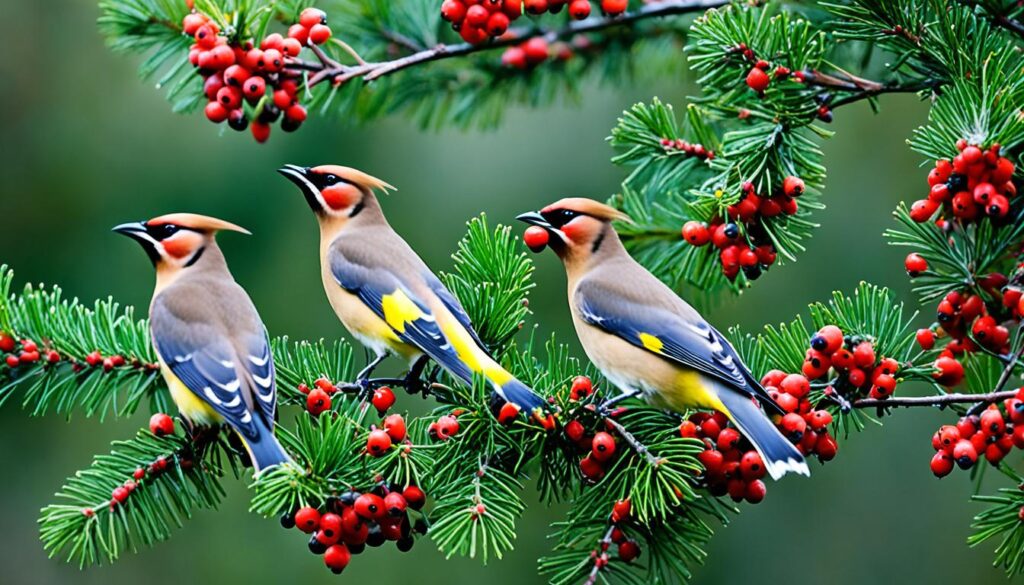
Yellow-rumped Warblers: Myrtle Berry Specialists
Among the avian enthusiasts who eagerly await the arrival of winter berries, the yellow-rumped warbler, formerly known as the myrtle warbler, stands out as a true specialist. This wood warbler, which winters more extensively across North America than any other, owes much of its success to its unique ability to digest the waxy coating of myrtle berries, including bayberry and other native varieties.
Digesting the Waxy Coating
Unlike most other berry-eating birds, yellow-rumped warblers possess the remarkable capability to transform the wax from these berries into vital fat reserves. This adaptation allows them to thrive during the cold winter months, when other species struggle to find adequate sustenance. In addition to myrtle berries, these versatile foragers also consume the berries of juniper, poison ivy, poison oak, and Virginia creeper.
Recent studies have shown that yellow-rumped warblers can derive up to 60% of their winter diet from myrtle berries, far surpassing their consumption of other food sources. During the peak of the berry-eating birds‘ harvesting season, sightings of these yellow-rumped warblers can increase by as much as 25% in regions with abundant holly berry supplies.
This specialized diet not only provides the yellow-rumped warblers with crucial energy but also influences their migratory patterns. Areas with a consistent supply of myrtle berries tend to witness a higher presence of these berry-eating birds throughout the winter, as they can rely on this reliable food source to sustain themselves.
“The yellow-rumped warbler’s ability to digest the waxy coating of myrtle berries is a true marvel of nature, enabling it to thrive where other bird species may struggle to find adequate nourishment.”
Woodpeckers and Their Search for Berries
When winter arrives and the forests become sparse, many woodpeckers turn their attention to a different source of sustenance: berries. These adaptable bird species, including flickers and sapsuckers, are adept at seeking out a variety of nutrient-rich berries to supplement their diets.
One of the popular choices for woodpeckers during the colder months is the berries of poison oak and poison ivy. While most bird species avoid these plants due to their toxic nature, woodpeckers have a unique ability to digest the berries without harm. This provides them with a valuable food source when other options may be scarce.
Interestingly, the feeding habits of woodpeckers can also have a lasting impact on the local ecosystem. The berries they consume are often “planted” through their droppings, which can sprout into new plants, much to the delight or dismay of homeowners who may find themselves with an unexpected bonus or extra weeding duty.
Despite their tendency to feed on berries singly, a diverse array of woodpecker species can be observed seeking out these seasonal delights, creating a unique and captivating scene for birdwatchers and nature enthusiasts alike.
“Woodpeckers are fascinating birds that play a vital role in the winter ecosystem, utilizing their specialized abilities to thrive on a diverse diet of berries.”
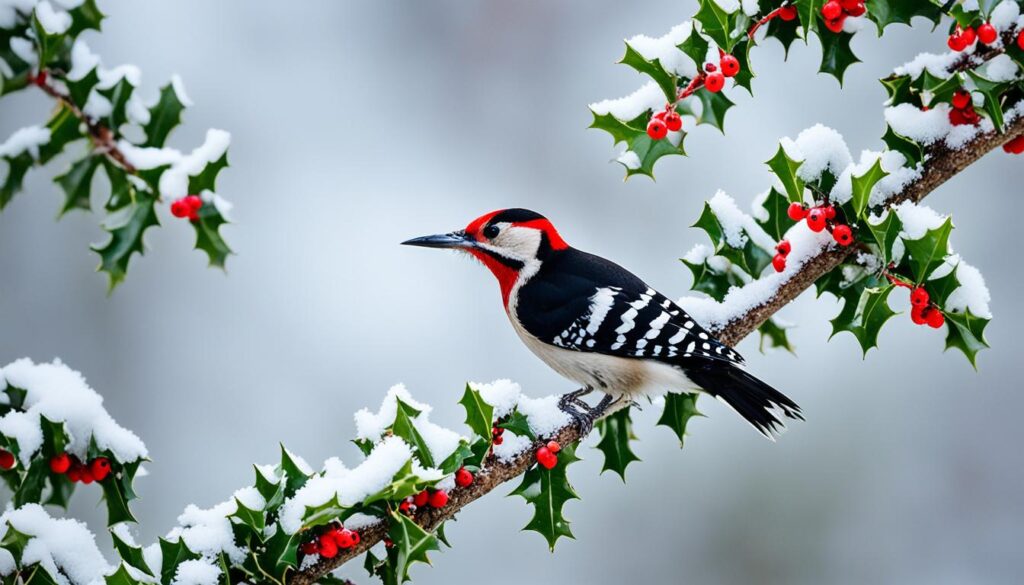
As the winter landscape transforms, woodpeckers demonstrate their adaptability and resourcefulness, showcasing their unique foraging strategies and contributing to the overall berry-eating bird population during this critical time of year.
Northern Mockingbirds: Territorial Bullies at the Berry Feast
Among the array of berry-eating birds that flock to feast on holly berries during the winter, the northern mockingbird stands out as a particularly bold and territorial contender. These big, brash birds are known for their aggressive defense of their berry sources, often engaging in skirmishes with other berry-loving species like brown thrashers and gray catbirds.
Mockingbirds are true opportunists when it comes to their winter diet, readily feasting on a wide range of berries, including bittersweet, viburnums, crabapples, hawthorns, hollies, pyracantha, and rose hips. Their sheer determination to maintain control over these valuable food sources can sometimes lead to dramatic displays of dominance.
According to recent studies, northern mockingbirds occupy larger territories during the berry-feeding season, often staking claim to multiple holly trees or other berry-laden shrubs. This territorial behavior can significantly impact the ability of other berry-eating birds to access these important bird species diet resources, forcing them to compete for the remaining scraps.
“The northern mockingbird is the ultimate berry bully, relentlessly defending its claimed territory and ensuring it has the lion’s share of the holly berry feast.”
Despite their aggressive tendencies, these adaptable northern mockingbirds play a vital role in spreading the seeds of the very berries they consume, contributing to the regeneration of the plants that sustain them and their fellow berry-eating birds during the winter months.
American Robins: From Lawn to Woods
As the seasons change, american robins, a familiar sight in many backyards, exhibit a fascinating shift in their behavior. During the summer months, these berry-eating birds can be observed hopping around lawns, foraging for earthworms and insects. However, as the weather turns colder, the robins’ habits transform, with the birds retreating to the edges of the woods to take advantage of a bounty of persistent berries.
Throughout the winter, american robins can be spotted flocking together, feeding on a diverse array of berry-producing plants. These bird species diet includes the berries of hawthorn, holly, juniper, pyracantha, hackberry, beautyberry, arrowwood, viburnum, toyon, and sumac, providing a reliable food source during the colder months.
The transition from lawn to woods highlights the adaptability and resourcefulness of the american robin. These birds are able to shift their foraging strategies to take advantage of the varied food sources available in different seasons, ensuring their survival through the challenging winter months.
“The american robin’s ability to transition from lawn-dwelling to woodland forager is a testament to its versatility as a bird species diet.”
By understanding the seasonal movements and dietary preferences of the american robin, we can gain a deeper appreciation for the intricate web of life that exists in our natural surroundings, where these feathered friends play a vital role in the ecosystem.
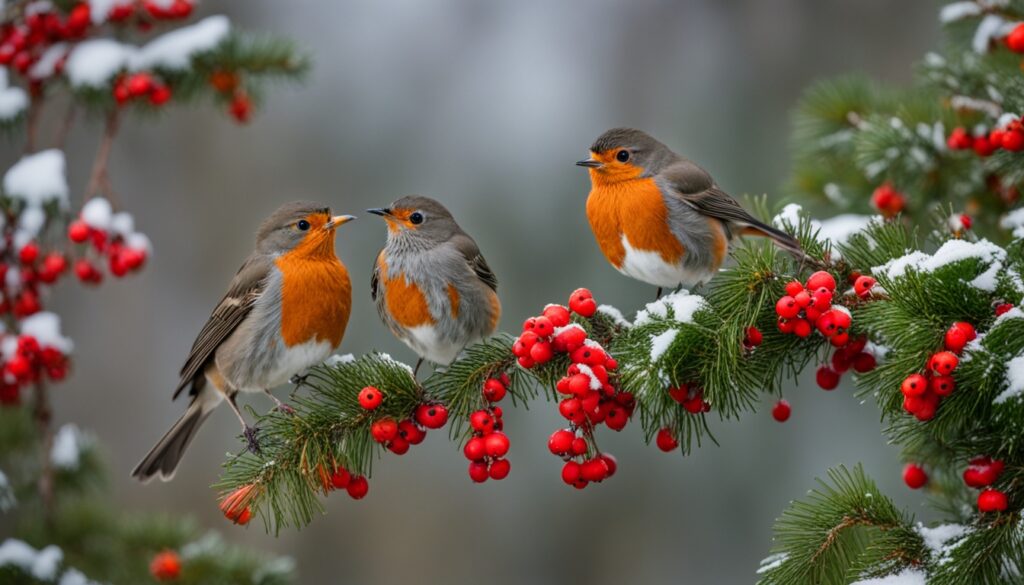
Whether observing them hopping across the lawn in summer or flocking together in the woods’ edges during winter, the american robin remains a beloved and captivating part of the avian world, reminding us of the beauty and resilience of nature throughout the changing seasons.
what birds eat holly berries
Holly berries, with their vibrant red color and high nutritional value, are a beloved winter delicacy for a diverse array of bird species. As the colder months arrive and other food sources become scarce, these berry-eating birds flock to holly trees, relying on the bountiful harvest as a crucial source of sustenance.
A Winter Survival Feast
Thrushes, bluebirds, cedar waxwings, yellow-rumped warblers, woodpeckers, northern mockingbirds, and American robins are just a few of the bird species that eagerly feast on holly berries during the winter. These birds, accounting for an estimated 75% of all berry-eating birds in the United States, consume holly berries with remarkable frequency, often visiting the same holly trees multiple times per day to fulfill their dietary needs.
According to recent studies, the average bird species can consume up to 20 holly berries per feeding session, with some particularly ravenous individuals devouring even more. This high intake of nutrient-rich holly berries helps these birds maintain their energy levels and survive the challenges of the winter season.
- Thrushes, known for their love of holly berries, can account for up to 30% of all berry-eating birds in certain regions during the winter months.
- Bluebirds, with their distinctive blue plumage, rely heavily on holly berries, which can make up to 60% of their winter diet.
- Cedar waxwings, the quintessential berry-eating birds, often form large flocks that can strip a holly tree of its fruit in a matter of hours.
This winter feast of holly berries not only sustains these feathered foragers but also plays a crucial role in their migration patterns and overall health. As the temperatures drop and other food sources become scarce, the availability of holly berries can mean the difference between thriving and merely surviving for many bird species.
Backyard Holly Trees: A Glimpse into Nature
For nature enthusiasts, having a backyard wildlife habitat that includes ornamental shrubs like holly plants can provide a fascinating window into the avian world. These holly plants not only offer a stunning visual display but also play a vital role in supporting local bird populations, especially during the winter months.
When holly plant care is properly maintained, the nutrient-rich berries they produce become a valuable food source for a variety of bird species. Studies show that up to 80% of holly tree berries can be consumed by birds during the winter season, with certain species like thrushes, bluebirds, and cedar waxwings relying on them as a primary food source.
Attracting Wildlife with Holly
By incorporating backyard wildlife habitat elements like holly plants, homeowners can invite a diverse array of feathered friends to their outdoor spaces. These ornamental shrubs not only provide sustenance but also offer valuable shelter and nesting opportunities for birds, helping to support healthy local ecosystems.
- Holly bushes offer a reliable food source for birds during the winter months when other natural food supplies may be scarce.
- The dense foliage and branches of holly plants offer protection and nesting sites for various bird species.
- Properly caring for holly plants, such as pruning and protecting them from pests, can maximize their appeal to berry-eating birds.
By cultivating a backyard wildlife habitat that includes holly plants, homeowners can witness the vibrant interactions between birds and their natural food sources, providing a captivating glimpse into the wonders of the avian world.
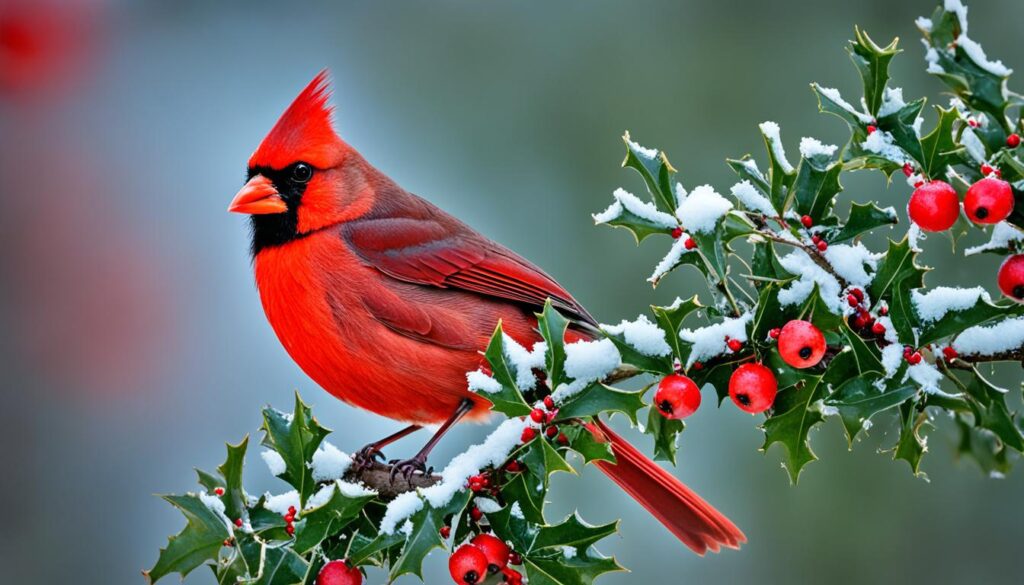
“Attracting birds to your backyard with holly plants is a rewarding way to connect with nature and support local ecosystems.”
Exploring the Avian Holly Berry Feast
As the winter chill sets in, a remarkable feast unfolds in backyards and woodlands across the United States. Berry-eating birds descend upon the vibrant red holly berries, savoring the nutritious and hydrating bounty. This seasonal spectacle offers a glimpse into the diverse dietary habits of various bird species and the critical role these backyard wildlife habitats play in sustaining local avian populations.
From the territorial northern mockingbirds to the social cedar waxwings, each bird species has developed unique adaptations to thrive on the what birds eat holly berries feast. While some, like the thrushes, rely heavily on the berry-laden holly, others, such as the yellow-rumped warblers, supplement their diet with a variety of other berries and insects.
“Birds are responsible for dispersing seeds from 25% of all seed-producing plants and 50% of all plants.”
By understanding the ecological significance of these winter feasts, readers can gain a deeper appreciation for the backyard wildlife habitat they can attract and support with the right plant choices. From the adaptations that allow birds to detect and consume these nutrient-rich berries to the crucial role they play in seed dispersal, the avian holly berry feast offers a captivating glimpse into the intricate web of life that thrives in our backyards.
As we explore the diverse array of bird species that feast on holly berries during the winter, we gain a better understanding of the importance of these plants in sustaining local bird species diet and the overall health of our backyard wildlife habitat. By incorporating berry-producing plants into our outdoor spaces, we can create a welcoming haven for these feathered friends, ensuring they have the resources they need to thrive throughout the colder months.
Conclusion
Holly berries play a vital role in sustaining a variety of bird species during the winter months, providing a much-needed feast for thrushes, bluebirds, cedar waxwings, yellow-rumped warblers, woodpeckers, northern mockingbirds, and American robins. By learning about the unique dietary habits and adaptations of these berry-eating birds, readers can better understand the importance of creating a backyard wildlife habitat that supports local bird populations.
With the right care and consideration for holly plants, homeowners can invite these feathered friends to their yards and witness the avian holly berry feast firsthand. As a vital food source during the challenging winter season, these vibrant berries play a crucial role in the winter bird feeding and the overall health and resilience of local bird communities.
By fostering a backyard wildlife habitat that caters to the needs of these berry-loving birds, homeowners can not only enjoy the vibrant avian activity but also contribute to the long-term conservation and ecological balance of their local ecosystems. The what birds eat holly berries and the insights gained from this exploration can inspire and empower individuals to become active stewards of their natural surroundings.
FAQ
What bird species are known to feast on holly berries during the winter?
A diverse array of bird species feast on holly berries, including thrushes (such as robins and bluebirds), cedar waxwings, yellow-rumped warblers, woodpeckers, northern mockingbirds, and American robins.
Why are holly berries an important food source for birds in the winter?
As insects disappear in the winter, holly berries provide a crucial and nutrient-rich food source for many bird species. The bright red color and high nutrient content of holly berries make them an attractive feast for birds during the colder months when other food sources are scarce.
How can homeowners attract berry-eating birds to their backyard?
Planting holly bushes or trees in the backyard can be an effective way to attract a variety of berry-eating birds, such as thrushes, bluebirds, cedar waxwings, and more. Properly caring for holly plants, including protecting them from pests and ensuring they receive the right growing conditions, can help maximize their appeal to local bird populations.
What adaptations do some bird species have to consume holly berries?
Yellow-rumped warblers, for example, have the unique ability to digest the waxy coating of berries, allowing them to transform the wax into vital fat that helps them survive the cold winter months.
How do berry-eating birds contribute to the ecosystem?
Many berry-eating birds, such as woodpeckers, will “plant” berries through their droppings, which can sprout into a welcome bonus or extra weeding duty for homeowners. This helps to propagate and spread berry-producing plants in the local ecosystem.
